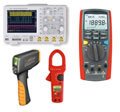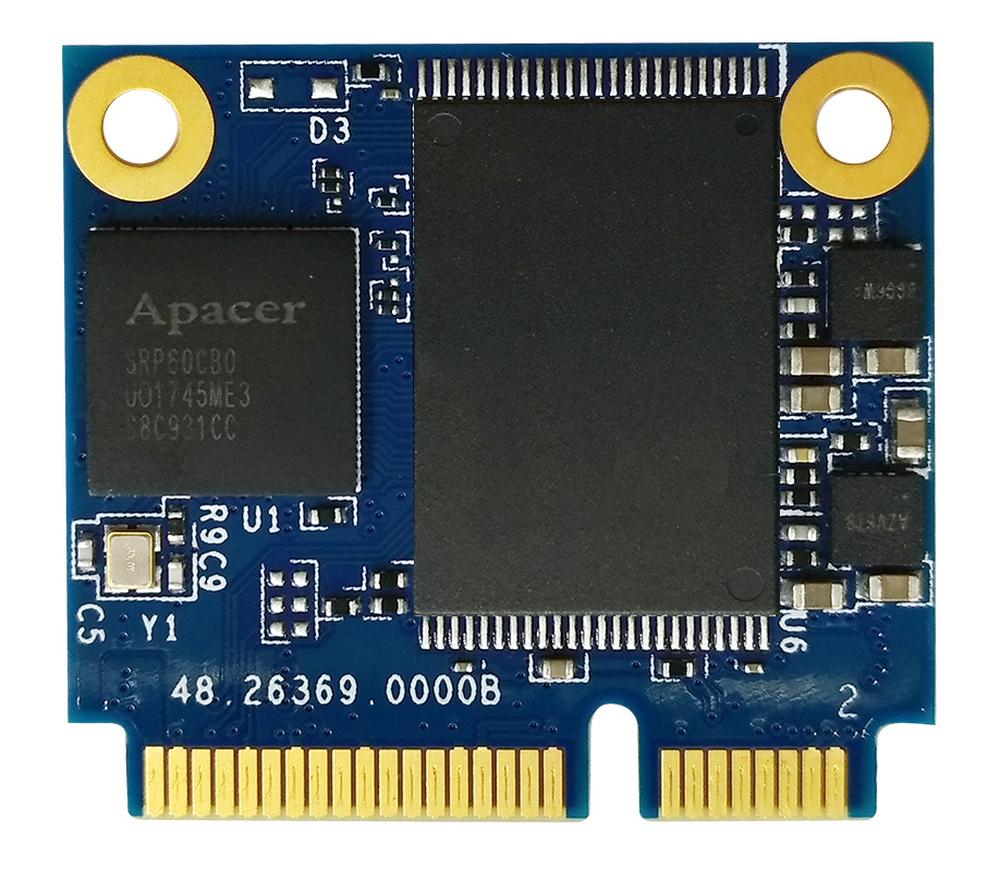Az Apacer bemutatja új ST170 sorozatát 2.5" SSD, M.2, mSATA, MO-297, CFast és uSSD változatokban.
A termékek megbízhatósága és ugyanakkor rendkívüli hatékonysága érdekében a következőket használják:
• Hibajavítás / észlelés
• Adatvédelem áramkimaradás esetén
• Hibás memóriablokkok kezelése
• Globális kopásellenőrzés – a termékben az összes flash chipben található tartalék blokkokat együtt kezelik. A vezérlő megpróbálja egyenletesen elosztani a bejegyzéseket a flash memóriablokkok között. Az algoritmus hatékonyságát a Max. erase count és Avg. erase count SMART attribútumok segítségével lehet megállapítani.
• Végponti (End-to-end) adatvédelem - Egy funkció, amely olyan módon kiterjeszti a hibaellenőrzést, hogy az lefedje a számítógéptől SSD-ig terjedő teljes útvonalat, és biztosítsa az adatok integritását az elérési útvonal több pontján.
• SMART (Self-Monitoring, Analysis and Reporting Technology)
• Hőérzékelő – rendszeresen ellenőrzi a Temperature SMART attribútumot, és csökkenti az SSD üzemi hőmérsékletét, hogy az ne haladja meg a 70°C-ot.
• Oldalszintű flash-transzlációs réteg
• Hyper cache technológia - az elérhető kapacitás egy részét SLC (1 bit/cella) NAND flashként használja. Csupán két értéket (0, 1) ír a nyolc helyett.
• Over-provisioning - az SSD kapacitás bizonyos része kizárólag a hatékonyság növelésére szolgál (Garbage Collection) - különösen akkor, ha az SSD teljes kapacitása ki van használva, vagy vegyes (szekvenciális véletlenszerű) munkaterhelés alatt áll.
• TRIM-támogatás - a parancs engedélyezi az operációs rendszer számára, hogy tájékoztassa az SSD flash vezérlőt olyan blokkokról, amelyek szükségtelen adatokat tartalmaznak, ezek jellemzően az operációs rendszer által törölt adatok. A vezérlő ezután törli a felesleges blokkokat és további használat céljából felszabadítja azokat.

Hibajavítás / észlelés
Amikor az alkalmazás adatokat tárol az SSD-re, flash vezérlő végzi a firmware-információk és az ECC írását (hibajavító kód) a flash memóriába. Az SM210-25 sorozatú SSD-k esetén a vezérlő 40-bit BCH (Bose-Chaudhuri-Hocquengham) ECC-t ír 1KB adatra. Amikor a vezérlő beolvassa az adatokat a flash memóriából, ECC segítségével ellenőrizheti az adatok érvényességét és javíthatja a hibákat. Az ST170 sorozat kis sűrűségű paritásellenőrzést (LDPC) használ ECC kódként. A normál olvasáshoz, amely nem módosítja a memóriacellákhoz csatlakoztatott referenciafeszültséget (kemény dekódolás), ez valamivel jobb hibajavítást tesz lehetővé, mint a BCH kód. Ha a vezérlő nem tudja kijavítani az adatok hibáit, a soft dekódolási módot használják. Ebben a módban a vezérlő többször is elolvassa a flash adatait különböző referenciafeszültségekkel, amelyek a memóriacellás kapukhoz kapcsolódnak. A lágy dekódolás sokkal jobb hibajavító képességgel rendelkezik, de a többszörös olvasás lassabb olvasási teljesítményt jelent.
A hibajavító/észlelési állapotot a SMART Bad Cluster Table Count attribútum olvasásával ellenőrizheti.
Hibás flash-blokk kezelés
A gyárból kikerülve a flash chip minimális számú kezdeti hibás blokkot tartalmaz. Jelenleg nem létezik olyan technológia, amely hibás blokkoktól mentes flash chipet gyártana. Ezen kívül más hibás blokkok is kialakulhatnak a programozás/törlés során. Mivel a hibás blokkok megjelenése elkerülhetetlen, az egyetlen megoldás az, ha irányítás alatt tartjuk azokat.A hibás blokkok időszerű számának ellenőrzését a felhasználó végzi a SMART Total later bad block count attribútum segítségével.
Adatvédelem áramkimaradás esetén
Az áramkimaradás során fellépő adatkárosodás megelőzésének legjobb módja az, ha megakadályozzuk az áramkimaradást. Ez nem mindig lehetséges, ezért az ST170 sorozat számos védelmi mechanizmust biztosít az adatok védelme érdekében. 1. A leképezési táblázat védelme A táblázat olyan rekordokat tartalmaz, amelyek a flash memória oldalainak fizikai címéhez logikai címeket rendel hozzá. Az oldalszintű leképezés kiváló véletlenszerű írási sebességet biztosít, de sok memóriát igényel a leképezési táblázat tárolásához. Az írási művelet során a vezérlő felveszi a flash adatait és térképinformációit, és frissíti a táblázatot RAM-ban. Áramkimaradás esetén a térképtábla elveszik, mivel nincs elegendő idő a flash-be való bejegyzésre. Az áramszolgáltatás helyreállításával a vezérlő blokkonként olvassa a flash-t, fokozatosan visszanyeri a táblázat egyes részeit, és újraépíti azt a RAM-ban. Ha a kezdeti olvasás során nem sikerül teljesen helyreállítani a táblázatot, a vezérlő addig folytatja az olvasást, amíg a táblázat teljesen vissza nem áll.2. Last Write Protection
A flash memória nem írható felül, így a P1 blokk frissítéséhez a B1 blokkban a firmware a P1 'új verzióját írja a B2 blokkba. Ha az áramkimaradás a P1' oldal írását érinti, akkor a művelet végrehajtása sikertelen is lehet. A tápellátás helyreállítása után az EEC firmware észleli, és ha lehetséges, akkor kis is javítja a P1' oldal hibáját. Ha a korrekció lehetetlen, akkor a P1 előző verziójának firmware-t használják, és a szemétgyűjtési algoritmus (garbage collection) gondoskodik az érvénytelen P1’ oldalról.
3. HyperCache
A sorozat nem használja a DRAM gyorsítótárat, amely áramkimaradás esetén elveszti az adatokat, mivel nincs elegendő idő az adatok gyorsítótárból flashre történő másolásához. Ehelyett a hyper cache-t használják.
Ellenőrizze, hogy a hibás blokkok száma (Total later bad block SMART attribútum) arányosan növekszik-e az Unexpected Power Loss Count attribútummal. Amennyiben igen, megfelelő óvintézkedéseket kell tennie az áramkimaradás elkerülésére.

SMART
A SMART a Self- Monitoring, Analysis and Reporting Technology, azaz Önellenőrző Értékelő és Hibajelentő Technológia rövidítése. Megfigyeli a fontos SSD paramétereket a proaktív intézkedések meghozatalához, amivel megakadályozható az SSD meghibásodása.A támogatott paraméterek teljes listája megtalálható az adatlapokban. Egyes fontos attribútumok jelentését már leírtuk. További fontos paraméterek:
Lifetime left - százalékban megadott érték, a 100% új SSD-t jelent, a 0% pedig teljes mértékben elhasznált típust – az ilyen SSD azonnali cserére szorul. Az ST170-25 nem szolgál ezzel az információval, de kiszámolható az „Avg. erase count” attribútumból.
Lifetime left = (1 - Avg. erase count/PE Cycle) x 100, PE Cycle=3 000 (az MLC flash alapú termékekhez hasonló érték)
SSD Protect Mode
• 0: R / W - normál állapot
• 3: Csak olvasható
• 7: Csak olvasható, szokatlan helyzet (akkor fordul elő, ha nincs elég szabad blokk, vagy ha számos hibás blokk keletkezik)
Az SSD védekezés szempontjából olvasási üzemmódra vált, ha a törlések átlagos száma meghaladja a 3000. ciklust, vagy ha a 7. paraméterben leírt helyzet áll fenn.
SATA PHY Error Count - a kommunikáció problémáit jelzi. Ezeket például hibás kábel vagy csatlakozók okozhatják.
Az új SSD ST170 sorozatot már megtalálja kínálatunkban, és kérésre lesz elérhető.
Ugyanakkor lehetőséget kínálunk arra, hogy mintadarabokat rendeljen tesztelés céljából kedvezményes áron. Az elérhető modellekről a weboldalunkon tájékozódhat.
További APACER termék iránti érdeklődésével, vagy egyéb információval kapcsolatban kérjük, lépjen velünk kapcsolatba az apacer@soselectronic.com címen.
Önnek is tetszenek cikkeink? Ne maradjon le egyről sem! Nem kerül erőfeszítésébe, mi eljuttatjuk Önhöz.





















